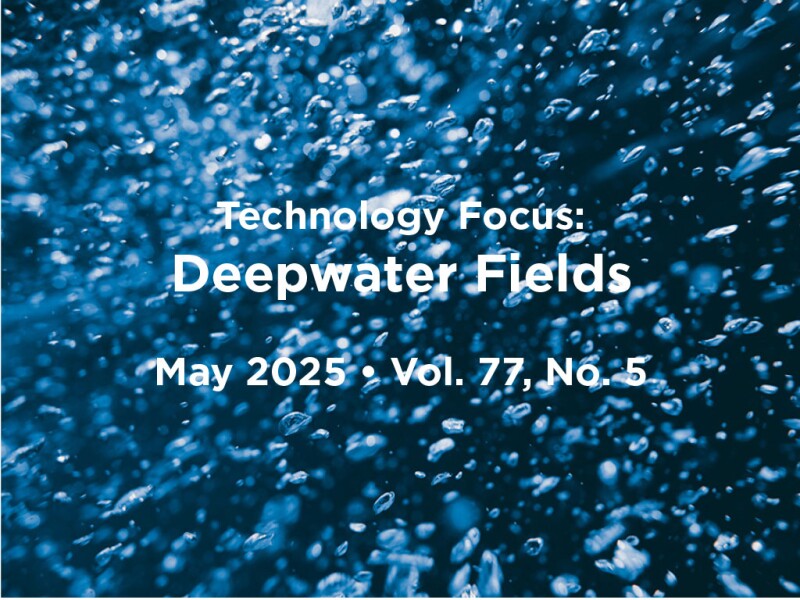This year’s Deepwater Fields feature highlights a trio of papers by SPE conference authors reflecting a range of upstream criticalities, including reservoir characterization, flow assurance, and drilling optimization. Effective exploitation of deepwater assets, which often present extraordinary challenges, requires continuous flexibility, reflected in the approaches developed in these papers.
Sabah Block H, a deepwater gas asset in Malaysian waters, is the setting for paper IPTC 24621, in which the operator was faced with the quandary of avoiding the formation of hydrate plugs during cold-start operations. The solution was the development of a sensor to monitor and control the Joule-Thomson cooling effect, thereby avoiding hydrate plugs at the subsea tree and consequent effects. With the implementation of the sensor, subsea production was maximized in the field.
In paper SPE 220770, the authors tackle the issue of well collision while drilling from an offshore platform or a multiwell pad caused by the proximity of offset wells. To mitigate this possibility, a new ranging technique was introduced that uses definitive dynamic surveys (DDS) from a rotating measurement-while-drilling tool that operates without the need to stop for a stationary survey for ranging. The authors write that DDS-survey technology provides an execution strategy that allows significant efficiency gains in the process of acquiring ranging data while also increasing the data density of real-time, continuous six-axis survey data along the entire wellbore.
At the reservoir-characterization level, the authors of paper IPTC 23723 provide a study that investigates reservoir fluid dynamics processes that explain the reasons behind varying oil compositions and properties within and across different reservoir compartments. In addition, they explore how to infer fluid implications with wireline-logging measurements, illustrating that, through analysis of reservoir-fluid chemical and geochemical measurements, the current state of thermodynamic equilibration can be determined. In both deepwater fields and other assets, understanding of the fluid implications of hydraulic-connectivity profiles is critical for reservoir description and field development planning.
Summarized Papers in This May 2025 Issue
IPTC 24621 Virtual Sensor Development Aims To Help Avoid Hydrates in Deepwater Gas Field by Suphawat Kiertkul and Syed Mohd Halim Syed Nasir, PTTEP
SPE 220770 Ranging Technology Manages Well-Collision Risk Without Affecting Rig Time by Mahmoud ElGizawy, and Rustam Rakhmangulov, SLB, and William T. Allen, BP
IPTC 23723 Reservoir-Fluid Geodynamics Enable Insights Into Reservoir Connectivity by Tarek S. Mohamed and Carlos Torres-Verdin, The University of Texas at Austin, and Oliver C. Mullins, SLB
Recommended Additional Reading
SPE 220794 Development and Qualification of a High-Angle Multifrac Completion System for Deepwater Subsea Wells by Sanjay Vitthal, Shell, et al.
SPE 221448 Influx Detected and Circulated Out Entirely With MPD on the First Deployment of MPD on Deepwater Rig: A Description of the Well‑Planning and -Execution Process by T. Smith, Shell, et al.
OTC 35370 Where Deep Space Meets the Deep Ocean—Exploring the Extreme Environments of Space and Deepwater by Hosam Abu Zeid, Consultant, et al.
SPE 221429 100+ Deepwater MPD Wells Learnings by A.A. Fernandes, Petrobras, et al.

Chris Carpenter joined SPE in 2001, starting his career as an associate editor and then managing editor of SPE’s peer-reviewed journals. In 2013, he joined the staff of the Journal of Petroleum Technology as technology editor. He is responsible for Technology Focus feature synopses of selected SPE conference papers and is liaison for the JPT Editorial Review Board. He has also served as an adjunct professor of English for several Texas community colleges since 2001. Carpenter holds a BA degree in history from Hendrix College, an MA degree in English from Texas A&M University, and an MFA in writing from the University of Arkansas. He can be reached at ccarpenter@spe.org.

